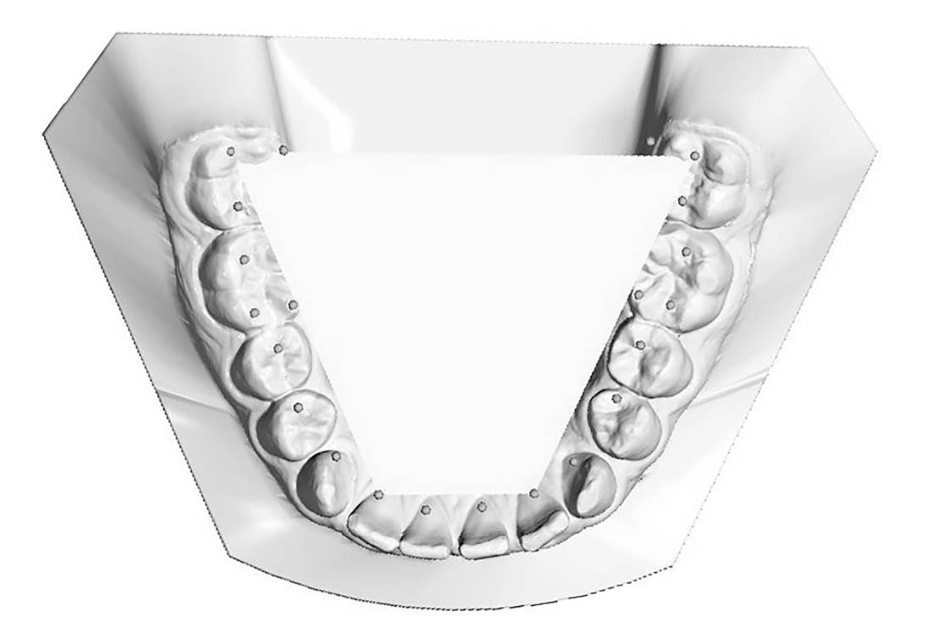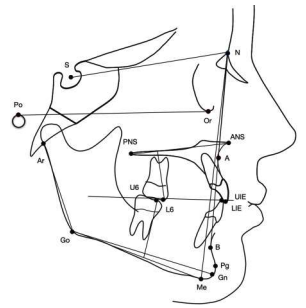Saveria Loberto, Chiara Pavoni, Silvia Fanelli, Letizia Lugli, Paola Cozza and Roberta Lione.
Abstract
Background to evaluate the predictability of expansion achieved in patients in early mixed dentition treated with Clear Aligners (CA), analyzing the efficiency of the expansion at the end of the first set of aligners and at the end of the therapy in the upper and lower arch.
Methods 36 patients (20 F, 16 M; mean age 8.3 ± 1.5 years) were selected retrospectively from the Department of Orthodontics of the Hospital of Rome “Tor Vergata”. All subjects were treated with CA with no other auxiliaries than attachments. For each patient a standardized sequential expansion protocol was planned for both arches. Digital dental casts were created at three observation periods from an intraoral scanner: prior to treatment (T0), at the end of the first set of aligners (T1), at the end of treatment (T2). The 3D models in planned position determined by the first Clincheck (CC) were obtained for comparison with T1 and T2. Six linear transversal measurements were used to evaluate the dimensional changes and the predictability of expansion movements, comparing T1-CC and T2-CC.
Results a statistically significant increase within the pre-treatment and the final outcomes for all the variables examined was found. In the upper arch, the greatest level of predictability was detected at the level of the first (46.44%) and second deciduous molar width (44.95%) at T1. The analysis of T2-CC changes showed a significant increase in the percentage of predictability of expansion at the level of the first permanent molars, at mesial (54.86%) and distal (58.92%) width. In the lower arch, a higher percentage of predictability than the upper arch was reported at T1-CC and T2-CC, with the greatest values at the level of second (T1-CC: 48.70%; T2-CC: 75.32%) and first deciduous molar width (T1-CC: 45.71%; T2-CC: 72.75%).
Conclusions CA can induce significant transversal increments. The predictability of expansion is variable, but it did not exceed the 50% during the first set of aligners. It was necessary to apply refinement set to achieve a good predictability for expansion of about 70%. The expansion in the lower arch was observed to be more predictable than in the upper arch.
Keywords Maxillary expansion, Mandibular expansion, Clear aligner, Predictability, Interceptive treatment, Mixed dentition, Transversal changes, Digital dental casts
Background
Interceptive orthodontics has the purpose of preventing or improving occlusal problems that might be happen- ing in the transition period from deciduous to permanent dentition [1]. According to the existing literature [2], the malocclu- sions which should be treated promptly are anterior or posterior crossbites, dento-skeletal Class III, Class II malocclusions with increased overjet, open-bites and dento-basal discrepancies associated with tooth eruption disorders. Most of these malocclusions are characterized by impaired transversal maxillary growth associated with causes of dysfunction, such as functional lateral devia- tions or oral habits, essential in preventing the onset of structural alterations [3–8]. The transverse maxillary problems result from a sym- metric or asymmetric constriction of the basal and/or dentoalveolar arch, with or without posterior crossbites depending upon the severity of the condition [9]. Rapid Maxillary Expansion (RME) is the most effective ortho- pedic procedure to increase the maxillary transverse dimension in young patients by opening the midpalatal suture [10–12]. However, if the transverse discrepancy has a dentoalveolar etiology, the expansion treatment could be performed exclusively at the dentoalveolar level [13].
The transversal expansion achieved with CA is use- ful in the correction of non-skeletal malocclusions and to resolve crowding, improving the dental arch form by inducing dento-alveolar changes. In cases of skeletal problems, the treatment must be performed with ortho- pedic device with skeletal effects, necessarily [17].
Recently, several authors [14–18] evaluated the dimen- sional changes of the upper arch obtained using CA, reporting an increase of the dentoalveolar maxillary width, with the greatest net improve at the level of upper first deciduous molars (+ 3.7 ± 1.4 mm) and at the level of upper second deciduous molars (+ 3.4 ± 1.6 mm) [16].
To our best knowledge, only two studies in literature analyzed the predictability of expansion in upper and lower arches obtained in patients in mixed dentition. Gonçalves et al. [19], analyzing 3D digital models of the dental arches of 24 children at pre-treatment, at the digi- tal planning predicted tooth positions, and at achieved tooth positions after treatment with the first round of aligners, reported that the mean efficiency of CA in mixed dentition for the expansion movements in the maxillary arch (mean efficiency: 62.6 ± 18.3%) was slightly greater than in the mandibular arch (mean efficiency: 61.6 ± 32.1%).
More recently, Kim et al. [20] quantified the predict- ability of arch expansion in children with early mixed dentition treated with CA using digital models obtained at pretreatment, predicted and posttreatment stages for both the maxillary and mandibular arches and assessed the main clinical factors for the predictability of arch expansion. The authors reported that the predictability of arch expansion was significantly higher in the mandibu- lar arch (mean efficiency: 76.25 ± 20.14%) compared to the maxillary arch (mean efficiency: 63.85 ± 21.47%) and significantly lower in the first permanent molars (maxil- lary 53.4 ± 25.8%, mandibular 69.4 ± 21.5%) than in the other deciduous teeth.
Nevertheless, both studies analyzed the predictabil- ity of expansion in a single observation time, specifically at the end of the first set of aligners or at the end of the treatment. Thus, the aim of this retrospective study was to evalu- ate the predictability of expansion achieved in patients in early mixed dentition treated with Clear Aligners, analyz- ing the efficiency of the expansion at the end of the first set of aligners and at the end of the therapy. The null hypothesis tested was that one set of aligners with a planned expansion about 4–6 mm is necessary to achieve a good predictability of arch expansion in both the maxilla and the mandible.
Methods
This study project was accepted by the Ethical Commit- tee of the Hospital of Rome “Tor Vergata” (Protocol num- ber: 48/23) and minor subjects’ parents signed a consent form. The study group comprised a sample of 36 patients (20 females and 16 males), with a mean age of 8.3 years ± 1.5 years, who was treated at the Department of Orthodon- tics of the Hospital of Rome “Tor Vergata” from January 2022 to December 2023. The following inclusion criteria were considered for participation in the current study: European ances- try, early mixed dentition stage with fully erupted first permanent molars, posterior transverse discrepancy between maxillary and mandibular arches up to 6 mm, with or without cross-bite, and good compliance with aligners. Exclusion criteria included missing deciduous canines or molars prior to treatment, the presence of multiple or advanced caries, previous orthodontic treat- ment or use of other auxiliary appliances, tooth agenesis or supernumerary teeth and periodontal diseases. All patients were treated with Invisalign First System® CA with no other auxiliaries than Invisalign attachments.


